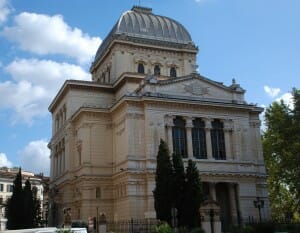
To gain an appreciation of the Roman Jewish ghetto experience, we participated in a walking tour offered by Micaela Pavoncello. For over a decade, Micaela has been sharing her knowledge of Italian Jewish history and customs with tourists from around the world. Her tours provide a slice of Roman History- the Jewish experience.
We started at a predetermined location near the Tempio Maggiore (synagogue) . Before Micaela escorted us into the synagogue and adjacent Jewish Museum, we stopped to look at a church. The Crucifixion scene included a biblical reference to Isaiah. The engraved inscription was in Hebrew. It was purposely included as a reminder to the ghetto Jews of the Catholic Church’s superiority. Numerous other churches were strategically placed along the perimeter of the ghetto in order to intimidate the Jews into converting to Christianity.
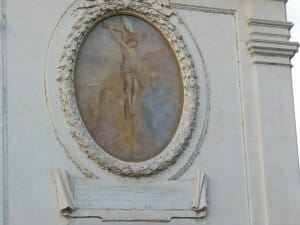
Like many other European Jewish communities, the Roman Jews were forced to live in a ghetto. In Rome, the church mandated residential and work restrictions that lasted from 1555 to 1870. The ghetto perimeter went from the Tiber River at the Tiber Island to the Ponte Quattro Capi, the Portico of Ottavia (or Fabricio), Via Portico d’Ottavia, Via Ottavia and finally to the Piazza delle Cinque Scole.
During that time period it was an unpleasant place to live since the river embankment tended to flood. From 1886-1904, the ghetto was leveled and measures were taken to eliminate flooding. A less dense neighborhood and a large new synagogue were constructed. The Tempio Maggiore was opened in 1904. Since most of the original ghetto was destroyed, there are a limited number of structures that remain. Instead, plaques recall a former place and time.
Italian police were stationed around the synagogue as a precautionary measure. Micaela reminded us that the synagogue suffered a brutal attack by terrorists in 1982. A small child was murdered and dozens were sent to a local hospital. Inside the museum, she pointed out a silver plated siddur (prayer book) with a noticeable bullet hole that pierced through the pages. The metal had acted as a shield and that saved the life of a non-Jewish visitor who later converted to Judaism.
Due to security concerns, photography is not permitted in the synagogue or the museum. Disappointingly, this seems to be standard precaution at many Jewish sites. Visitors are forced to take mental snapshots with the hope that their memories will not dim with time.
Our first stop inside the building was a small Sephardic sanctuary. We sat in wooden pews as Micaela told us interesting facts about the Jewish community. As she spoke, my eyes gazed upon the artifacts that came from the five synagogues that existed during the time of the ghetto. An eternal light glowed brightly in front of the ark. The original building that housed the five synagogues was destroyed.
In the main part of the museum, we viewed fading black and white pictures of the interiors of the five synagogues and some of the aron hakodeshes. (arks where the Torah scrolls were housed) Numerous glass enclosed cases held stunning Torah covers with priceless fabrics and Rimonim (the ornaments) that adorn Torahs. The Jewish community had the foresight to hide these Jewish treasures during the time of the Nazis. Only a handful of ancient Hebrew texts were on display. Most were destroyed during the ghetto years by the Church and in the 20th century by the Nazis.
These vestiges of past Jewish life are on display for visitors to see. Some are used by the community during Jewish holidays. What a wonderful way to connect the past with the present.
Micaela took us into the cavernous sanctuary of Tempio Maggiore. Upon entering, I immediately spotted its squared dome ceiling. Looking up we could not miss the rainbow motif (a reminder of the story of Noah) at the very top or the stars (be fruitful and multiply) that covered the second tier. Massive white pillars support a balcony seating area. Women, according to Orthodox Jewish tradition, are mandated to sit separately. This tradition has been maintained in this community despite other deviations from Jewish traditions.
The bimah (stage) and the aron hakodesh (Holy Ark) have a churchlike appearance. Micaela candidly told us that the designers were Christians.
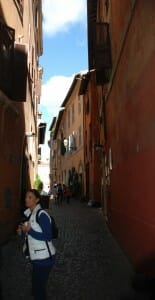
Micaela showed us a map that compared the modern street configurations with the congested and populated ghetto neighborhood. The differences were astounding. We walked down a few narrow streets that provided a small flavor of congested and segregated ghetto life.
At designated points, we were asked to look down at the pavement. Small bronze plaques are obscure reminders of the Jews who lost their lives during the Holocaust.
Micaela showed us the location of at least two of the ghetto gates. The lack of freedom coupled with the harassment mandated by the church made living conditions in the ghetto burdensome. Men venturing outside the ghetto walls were required to wear a pointed hat and women were forced to sew the symbol designated for prostitutes on their clothing.
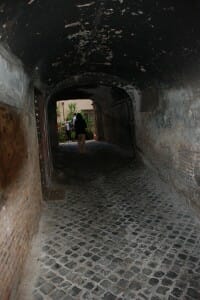
During our London Jewish walking tour, we passed a former matzah bakery. Engravings on the building were all that remained in London. On this Roman Jewish tour, Micaela pointed out a dark tunnel that once housed a matzah bakery.

After the Jewish ghetto was leveled, most Jews opted to move to other parts of Rome. Much to our surprise, many Jews have returned to this area. A flourishing Jewish day school is surrounded by kosher restaurants and Jewish owned shops. As our tour walked through the former ghetto, we smelled the aroma of freshly baked challah and heard people greeting one another with the familiar Friday afternoon greeting, “Shabbat Shalom.”
The picture below shows one of the main thoroughfares of the ghetto area. The width of this modern street stands in sharp contrast to the former ghetto streets seen above.
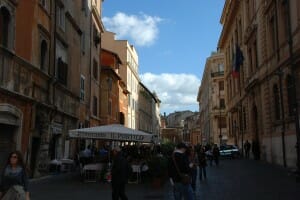
Strolling through this area on a Friday morning was quite different from our Friday afternoon visit to Barcelona. Due to the Inquisition, a Jewish presence in Spain was almost entirely eliminated. The Barcelona Jewish community no longer lives where the established Jewish community once prospered.
If you’re interested in a slice of Roman history-the Jewish ghetto experience, I’d recommend Micaela’s personable and informative tour. Her charming personality will definitely keep you engaged as she provides an overview of Roman Jewish history and culture.
MAY THIS BE THE BEST YEAR OF YOUR LIFE is available on Amazon.
I’d love to hear your honest feedback. Published authors thrive on blog comments, Amazon critiques, Goodreads reviews as well as other online book evaluations.
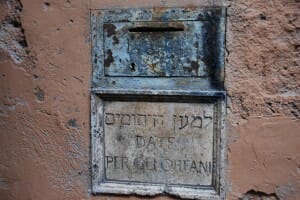
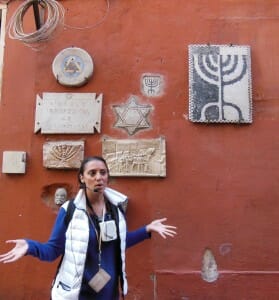
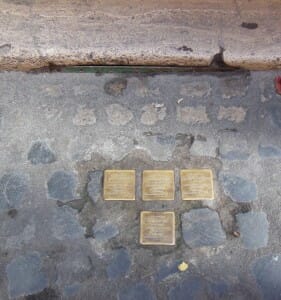
Leave a Reply
You must be logged in to post a comment.